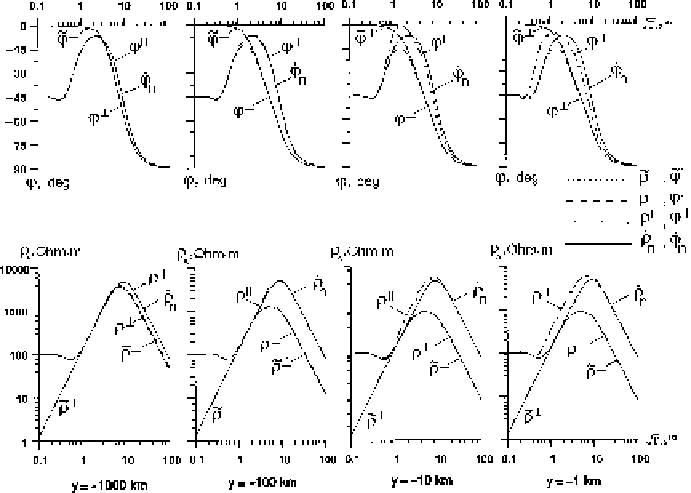Information Technology Reference
In-Depth Information
Fig. 7.10
Longitudinal and transverse apparent-resistivity and impedance-phase curves over the
left conductive segment in the model shown in Fig. 7.9;
y
-distance to the boundary between seg-
ments; ˜
⊥
,
⊥
-analytical solution,
⊥
,
⊥
and
,
-numerical solution by means of the finite
˜
1
,
1
element method, ˙
n
,
n
- locally normal solution. Model parameters:
˙
=
10 Ohm
·
m
=
10
5
100 Ohm
·
m
,
h
1
=
1km
,
2
=
Ohm
·
m
,
h
2
=
99 km
,
3
=
0
Figures 7.10 and 7.11 show the apparent-resistivity and impedance-phase curves
obtained over the left and right segments at different distances from the con-
ductance discontinuity.
First of all note that within the
⊥
-curves
plotted from the analytical and numerical solutions agree fairly well. The ascending
branches of the
S
1
- and
h
-intervals the transverse
⊥
-curves are not distorted. They coincide with ascending branches
of the locally normal
⊥
-curves
n
-curves. However, the descending branches of the
are distorted by the
S
-effect. They are shifted from the locally normal
n
-curves,
down over the left conductive segment and up over the right resistive segment. The
maximum
S
-effect is observed at the boundary between the segments. With distance
from the conductance discontinuity the
S
-effect monotonously decreases. It vanishes
at
y
3000 km over the left segment (
d
≈−
=
1000 km) and at
y
≈
1200 km
over the right segment (
d
316 km). These estimates are in a good agreement
with Table 7.1. Now have a look at the transverse phase curves. In passing to the
h
-interval the
=
⊥
-curves, plotted from the analytical and numerical solutions, merge
together and with lowering frequency they approach the locally normal
n
-curves.
A remarkable property of the
S
-effect is that the drastically shifted branches of the
⊥
-curves correspond to the slightly distorted branches of the
⊥
-curves.

